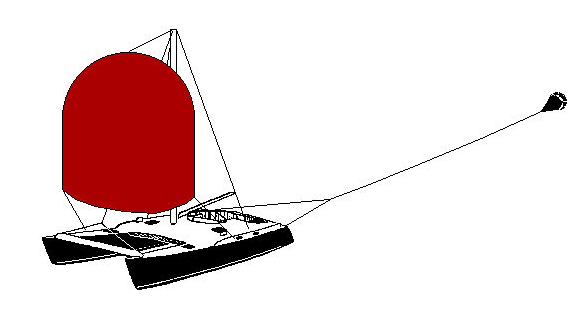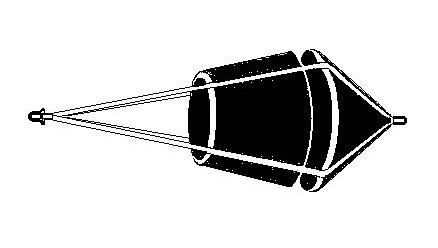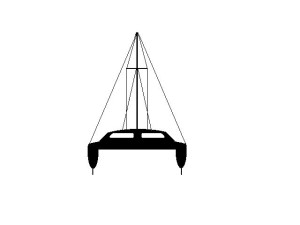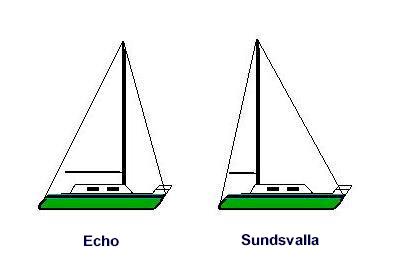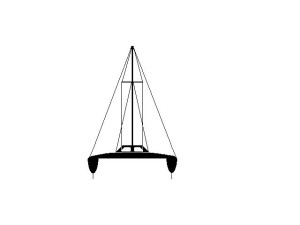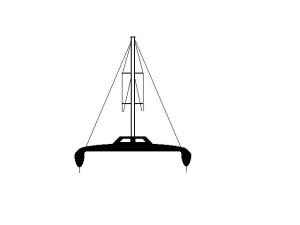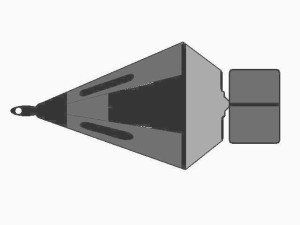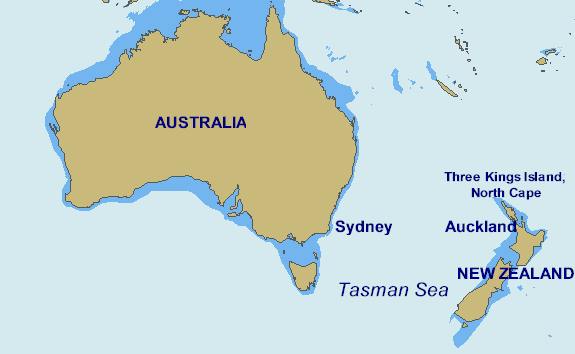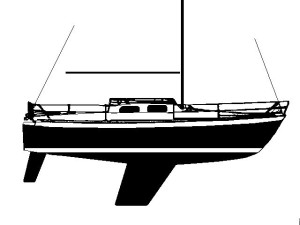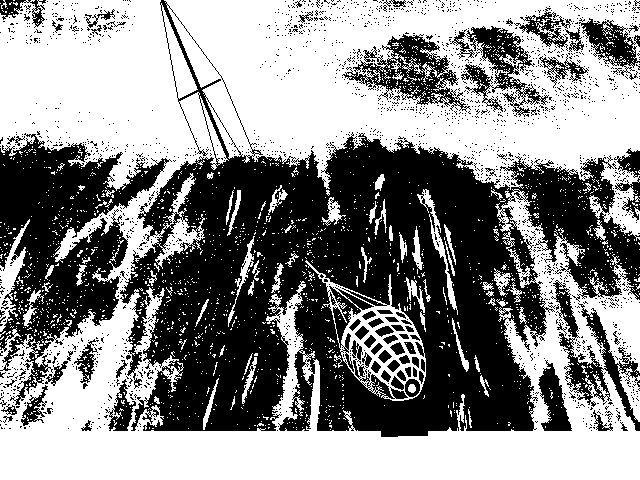D/C-5
Catamaran, Catalac
41' x 18' x 8.5 Tons
5-Ft. Diameter Hybrid Parachute
Force 12 Conditions
File D/C-5, obtained from Darryl and Diviana Wheeler, Auckland NZ. - Vessel name Heart Light, Catalac catamaran designed by Tom Lack, LOA 41' x Beam 18' x Draft 3' x 8.5 Tons - Drogue: 5-ft. Diameter hybrid parachute on 70' x 3/8" chain tether with bridle arms of 150' each (3/4" nylon braid) and 1/2" swivel - Deployed in the Queen's Birthday Storm (June 1994) in deep water about 400 miles south of Fiji, with winds of 80 knots and seas of 80 ft. - Vessel's stern yawed 30° with owner steering with the rudders and the engines - Speed exceeded 10 knots at times.
In 1987 Darryl and Diviana Wheeler sold their house in America and purchased Heart Light, a 41-ft. Catalac catamaran. They put out to sea, learning to sail as they went. They made it through the Panama Canal and across the Pacific to the Marquesas and Tahiti, arriving in New Zealand in November 1989, where Darryl worked for a number of years as a marketing consultant. On Tuesday, 31 May 1994, in spite of Diviana's premonitions, Daryl cast off a New Zealand dock, headed north. He wanted to sail to Tonga with the Tongan fleet - an annual regatta. On board were his wife, Diviana, their son, Shane, and their daughter-in-law, Stephanie. En route to Tonga they ran straight into what has since been called the Queen's Birthday Storm. Heart Light found herself in the worst part of the storm, flanked by the yachts that sustained the most damage, all within a 200-mile radius - Destiny to her left (File D/M-12), Pilot and Quartermaster to her right, Ramtha and Mary T up ahead, Silver Shadow and Sofia behind.
What transpired on Heart Light between June 4 and June 6 has to be regarded as one of the most remarkable feats of manual steering in the history of multihull sailing. All the more remarkable because in 16,000 sea miles Darryl Wheeler had never done the steering offshore - the autopilot had always taken care of that. Now, suddenly, he found himself perched in the driver's seat in the inside steering station, his hands clasped onto the wheel, Diviana's arms clasped about him - trying to keep him from falling off the chair.
The drogue used was a hybrid parachute, about 5 feet in diameter. In the course of numerous telephone conversations Victor Shane and Darryl Wheeler ascertained that it was not a BUORD. This parachute was light blue in color and seems to have been made of much lighter, non-porous material, perhaps Nylon Taffeta, or even heavy spinnaker Rip-Stop. It had less than a dozen shroud lines. It was deployed on a 75' chain tether, with 150' bridles made of 3/4" nylon braid. This bridle was shackled to heavy duty padeyes on the outboard ends of the catamaran's hulls - probably why it didn't chafe through.
As the storm built the catamaran started surfing down steep waves at speeds in excess of 10 knots with the drogue in tow. Already, in the few hours that he had been behind the wheel, Darryl had become an accomplished helmsman. And he had quickly learned how to make good use of Heart Light's twin inboard engines as well. Since the propellers were positioned 18 feet apart, by cutting one throttle and punching the other one Darryl soon found he could use rudders and engines in combination to keep the yacht more or less aligned downwind, in spite of the rogue waves that were hammering her from side to side.
With the lives of his family hanging in the balance Darryl became an expert at steering the boat down 60-ft. seas. The ride must have been incredible. The 41' x 18' catamaran all but became an Olympic toboggan, hurtling down the sides of sheer slopes, slamming sideways into rogue avalanches and occasionally falling off a precipice or two. The hulls and cross-arms were flexing. So were the huge windows, letting copious amounts of water in. Stephanie was perched on the floor, hopelessly sea sick. The entire yacht was wet and trashed, littered with food items and broken glass.
Many hours later, as the ordeal drew to a conclusion, a huge wave picked up the drogue bridle and threw it at the propellers. All lines became fouled. All engines useless. Heart Light was now dead in the water, lying a-hull. Darryl activated the EPIRB and deployed an 18-ft. Para-Tech sea anchor off the bow. The boat remained on station until they were taken off by the ship San Te Maru 18.
Those interested in a blow by blow account of the life and death saga that transpired on Heart Light can obtain a copy of Diviana's book, Heart Light, Rescue At Sea (Random House New Zealand Ltd., 18 Poland Road, Glenfield, Auckland 10, New Zealand). Here is a transcript of the DDDB feedback Victor Shane obtained from Darryl & Diviana Wheeler:
This is a recap of our experience using a drogue and para-anchor. The drogue was with the boat when we bought it. It was a 4-6 ft. diameter nylon chute. I had a swivel connected to 70 feet of chain that I could hook a bridle to and connect to each stern. During the storm I used my 150' bridle that was made for the para-anchor. As the storm started to build we were faced with the decision to para-anchor from the bow or deploy a drogue to help us steer and slow the boat. We had a lot of large windows on two levels across the front and as the waves were building, we decided it was in our best interest to run. A decision that proved itself to be correct under the unusual circumstances we later found ourselves in. Even if we had storm windows, we would not have para-anchored bow first into this tempest.
As soon as we deployed the drogue the boat became easier to handle. Every time she would want to broach the drogue would drag her back on course. As the wind built to a steady 77 knots gusting to 90 knots it would drive the 50 foot waves on top of one another. The faces of these monsters were vertical on both sides. In some cases the waves would stack 3 high, with the center wave becoming aerated. When you came off one of these giants the middle wave would drop out and the cat would free fall through the gap until hitting the next wave below.
Because of the height and steepness of the waves, plus the fact that every so often a group of waves would come from another direction, I feel that it would have been suicide to deploy the para-anchor from the bow. The New Zealand Air Force was reporting waves over 100 feet high from this stacking problem. We were careening down 100 foot waves under bare poles, sometimes reaching 13 knots dragging the drogue, doing our best to prevent a broach - we did find ourselves flying a hull more than once! When one of these monsters would break on top of us it was like a giant hand pushing us at will in any direction it chose. The power of these waves was so intense that if we were not moving in their direction we surely would have been damaged.
On our final broach waves pushed the rode from our drogue into our props. At that climactic point my engines were stuffed by missiles of sea water and my props were wrapped tightly in the drogue lines. We became dead in the water sitting sideways to the waves. After things calmed down to a mild roar of about 60 knots and the huge waves were no longer stacking, we did deploy our para-anchor to hold us in place. However, surprisingly, the cat did much better when free falling down the waves at that point. If we had not been intent on staying in ONE spot we would have cut it loose. The problem again, was the fact that we were getting hit broadside by rogue waves instead of just the seas moving on us from the front. It was terrifying sitting there jerking around and having the sea burst down on us, causing the windows to flex inwards and dump gallons of water inside the boat. Further confirmation to us that indeed we had made the right choice in running under these particular circumstances. I still feel that a para-anchor is a great line of defense for multihulls, I have successfully used mine on various occasions. It just was not practical in these extreme conditions. I hope and pray none of your readers will ever have the misfortune of being in a storm of this nature.
In the end, I will say from personal experience that the safest craft in this storm were the two catamarans. While our ordeal was horrific it was nothing in comparison to the monohulls that were being pitchpoled and rolling 360 degrees. Setting aside our experience of the event and looking at this from a seamanship point of view, we would offer the following. Make up your mind before you get in a situation of this type as to what you are going to do. Once you commit to a tactic it is almost impossible to change tactics. Even if we had wanted to, we could not have deployed a para-anchor during the storm. It was all you could do to just hang on, let alone shackle and deploy a drag device. Work out some sort of system so that if you are dragging a drogue and using your engines for control the rode is not carried into the props. Maybe a rope cutter on the shafts would work.
Love the Drag Device Database? Help us to keep it free for all mariners by making a tiny donation to cover our server and maintenance costs. Thank You!
